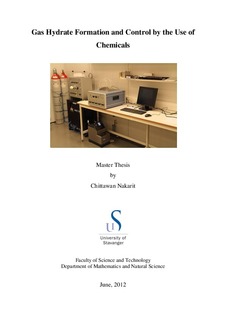| dc.contributor.author | Nakarit, Chittawan | |
| dc.date.accessioned | 2012-09-18T13:29:02Z | |
| dc.date.available | 2012-09-18T13:29:02Z | |
| dc.date.issued | 2012 | |
| dc.identifier.uri | http://hdl.handle.net/11250/182525 | |
| dc.description | Master's thesis in Environmental Technology | no_NO |
| dc.description.abstract | Gas hydrates formation and plugging of pipelines is becoming an even more serious problem in the oil and gas industry due to the exploration and development moving to more extreme locations. Kinetic hydrate inhibitors (KHIs) are one class of low dosage hydrate inhibitors (LDHIs) which are used to prevent hydrate plug in pipelines. They work by delaying gas hydrate formation by time periods dependent mainly on the subcooling (driving force) in the system.
The effect of various parameters on different kinetic hydrate inhibitors (KHIs) has been examined with high pressure rocking cell equipment (RC5 unit) in this thesis. Since no one has published a study to compare KHI performance between rocking rigs and autoclaves this has been investigated in this study. Constant slow cooling experiments were conducted until hydrate formation started (To value) and hydrate plug formation (Ta value) occurred. All the different apparatuses gave similar performance trends with high performance KHIs, but To was different with low performance chemicals. This may be due to the stochasticity of gas hydrate formation. The reproducibility of To and Ta values from RC5 are as good as both autoclaves.
The RC5 experiment at constant cooling showed that the KHI efficiency increased when concentration dose was increased from 2500 ppm to 5000 ppm. For all the experiments, the present of small amounts NaCl in aqueous solution decreased the onset and catastrophic hydrate formation temperature by 0.1-2.1oC compared with using DI water alone. This is beyond the thermodynamic hydrate inhibition effect of the salt and shows varying degrees of synergy with added salt. For ranking inhibitors at dosed 2500 ppm, the test results indicated the best chemicals is Inhibex Bio800 followed by Inhibex 101, Hybrane, PVCap 12k+TBAB, and Inhibex 501. Whereas at dosage of 5000 ppm, Inhibex Bio-800 inhibited hydrate formation as well as Inhibex 101. | no_NO |
| dc.language.iso | eng | no_NO |
| dc.publisher | University of Stavanger, Norway | no_NO |
| dc.relation.ispartofseries | Masteroppgave/UIS-TN-IMN/2012; | |
| dc.subject | gas hydrates | no_NO |
| dc.subject | flow assurance | no_NO |
| dc.subject | low dosage hydrate inhibitors | no_NO |
| dc.subject | kinetic hydrate inhibitors | no_NO |
| dc.title | Gas hydrate formation and control by the use of chemicals | no_NO |
| dc.type | Master thesis | no_NO |
| dc.subject.nsi | VDP::Mathematics and natural science: 400 | no_NO |
